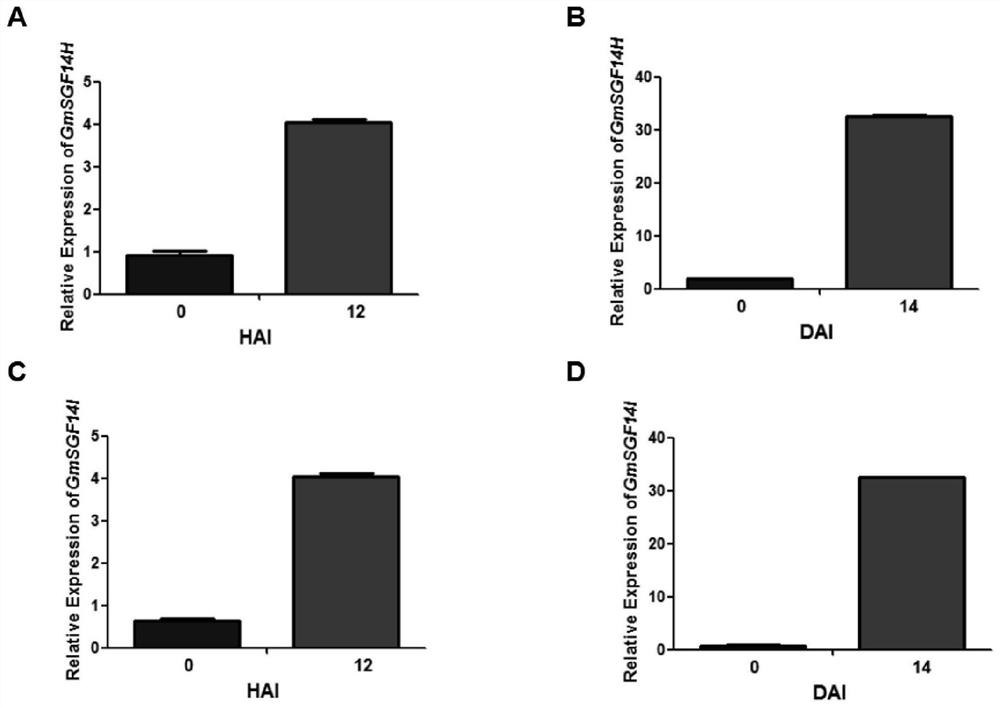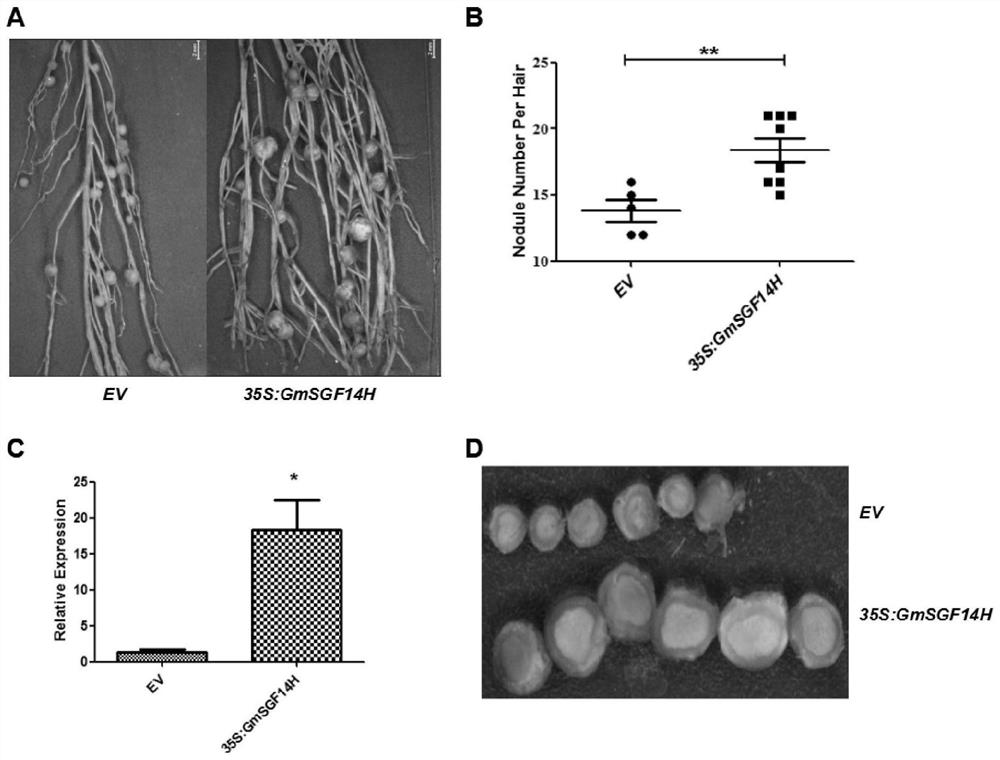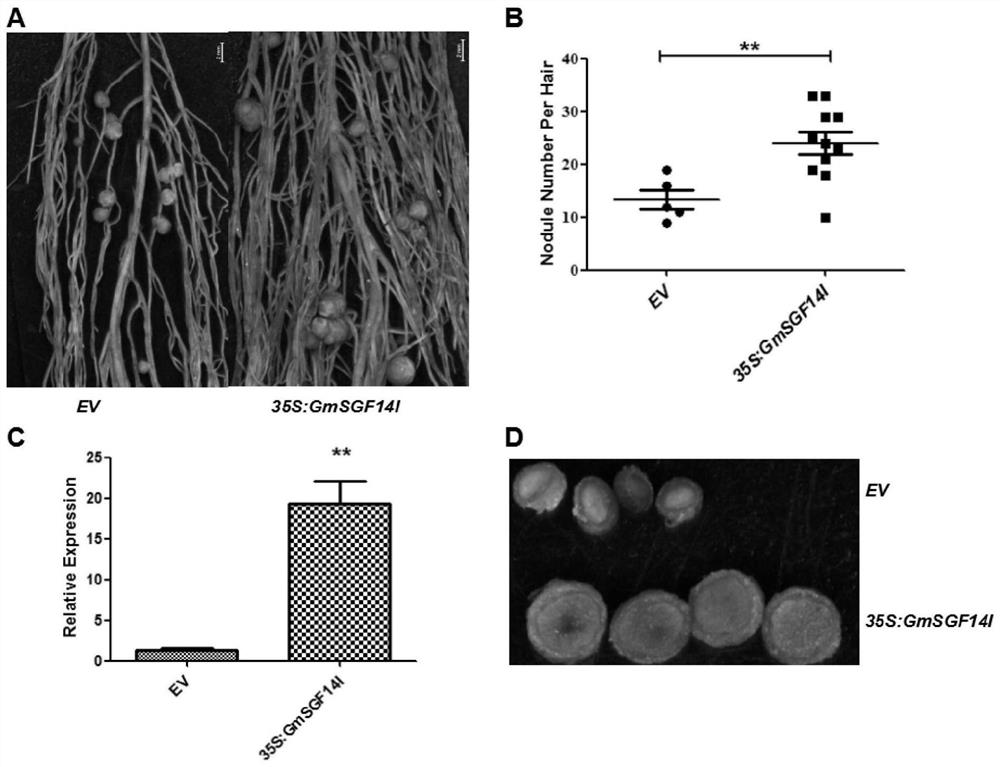A method for cultivating transgenic plants that increases the number of root nodules and promotes the development of root nodules
A technology of transgenic plants and cultivation methods, applied in the fields of botanical equipment and methods, chemical instruments and methods, biochemical equipment and methods, etc., can solve problems such as unreported research, and achieve the goal of increasing the number of nodules, promoting the maturation of nodules, and significantly increasing the number of nodules. The effect of practical value
- Summary
- Abstract
- Description
- Claims
- Application Information
AI Technical Summary
Problems solved by technology
Method used
Image
Examples
Embodiment 1
[0041] Example 1. Nomenclature and sequence of genes.
[0042] The invention relates to coding genes of soybean 14-3-3 family proteins GmSGF14H and GmSGF14I and applications thereof. The overexpression vector constructed by the present invention can specifically overexpress the GmSGF14H and GmSGF14I Gene. The genes are located on soybean chromosomes 4 and 6 respectively, and are named as follows, GmSGF14H (gene number: Glyma.04G099900), having the coding sequence shown in SEQ ID NO: 1; GmSGF14I (Gene number: Glyma.06G101500), having the coding sequence shown in SEQ ID NO:2.
Embodiment 2
[0043] Example 2. Expression analysis of GmSGF14H and GmSGF14I genes in response to rhizobia infection.
[0044] 1) Material acquisition: The material used in the experiment was Williams 82 (W82 for short); the material was carried out according to the following process: soybean seeds were sterilized with 70% alcohol for 30 sec, and sowed in the vermiculite substrate soaked in low-nitrogen nutrient solution. They were cultured in a culture room with 16 h light / 8 h dark, light intensity 7000 LUX, temperature 26 °C, and relative humidity 70%. 15 days after sowing, inoculate with rhizobia, each plant was inoculated with 30 mL of bradyrhizobium USDA110 bacterial solution (OD600=0.08), and the soybean roots were collected on the 28th day after inoculation.
[0045] 2) Isolation of mRNA: Trizol method was used to extract soybean total RNA. ①Put the tissue into a grinder and grind it with liquid nitrogen for 3 times, then add 0.1-0.2 g of the ground tissue into a 1 mL centrifuge tube...
Embodiment 3
[0054] Example 3. Cultivation of transgenic soybeans with high ability of nodulation and nitrogen fixation.
[0055] 1) Extraction of total RNA from root tissue of Wilimas82 soybean.
[0056] The mortar has been treated at 180 ℃ for 8 hours or burned to eliminate RNase contamination; reagents such as chloroform, isopropanol, and ethanol should be freshly opened and uncontaminated; other equipment such as pipette tips, centrifuge tubes and reagents such as ultrapure water , NaAc, were treated with 1 ‰ DEPC water overnight, and then sterilized at 121 ℃ for 30 minutes by high temperature and humidity.
[0057] (1) Take 100 mg of soybean root material and grind it with liquid nitrogen, add 1 mL of TRI pure reagent, and homogenize thoroughly, then suck the homogenate into a 1.5 mL centrifuge tube, and place it at room temperature for 5 min.
[0058] (2) Add 200 μl chloroform, vortex to mix, let stand for 5 minutes, 4 ℃, 12000 r / min, centrifuge for 10 minutes.
[0059] (3) Take th...
PUM
 Login to View More
Login to View More Abstract
Description
Claims
Application Information
 Login to View More
Login to View More - R&D
- Intellectual Property
- Life Sciences
- Materials
- Tech Scout
- Unparalleled Data Quality
- Higher Quality Content
- 60% Fewer Hallucinations
Browse by: Latest US Patents, China's latest patents, Technical Efficacy Thesaurus, Application Domain, Technology Topic, Popular Technical Reports.
© 2025 PatSnap. All rights reserved.Legal|Privacy policy|Modern Slavery Act Transparency Statement|Sitemap|About US| Contact US: help@patsnap.com



